The Truth About Cats and Artists
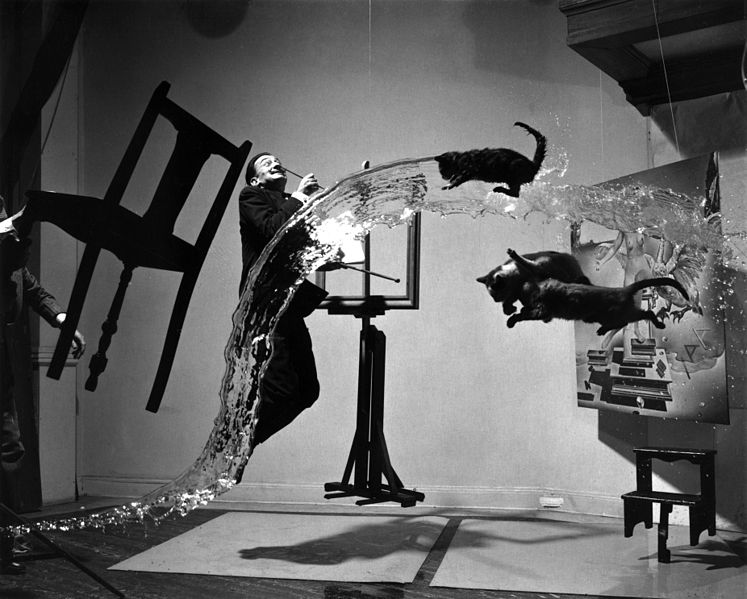
Every “Caturday,” the Smithsonian’s Archives of American Art Facebook page highlights a cat in an archival object in their collections. The array of their examples is vast, showcasing how artists have found inspiration and solace in their feline companions over the course of history. What is it about our feline friends that has captured the fascination of humans? This obsession with adoring the cat is still present in a myriad of ways: Facebook and the meme being two prime examples, not to mention the thousands of hours of cat videos on YouTube. Some have even argued that cats themselves are art: Leonardo Da Vinci proposedly said that “the smallest feline is a masterpiece.” 1 Yet the history of the cat and how they have become immortalised in art is a fairly complex progression. Like many animals there is a history of strong symbolic association with the cat that has moved from the worship of cat-headed gods to the killing of cats as witches’ familiars. They are recorded in many forms in different early cultures, used for social commentary, and made themselves at home in the artist’s studio. Much of the fascination of artists can be aligned in two forms: the historical and symbolic role of the cat, and the domesticated role of the cat.
The origins of the importance of cats
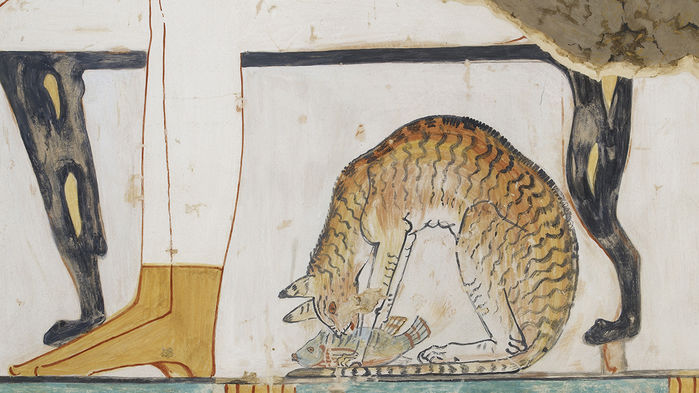
The progression of the domestication of the cat is fairly straight forward and is tied strongly to the move to an agricultural society. Ancestors of the modern cat can be traced back 10 million years, but they were wild. Unlike the dog that was actively domesticated as a hunting tool, the cat was domesticated in a more gradual process around their usefulness for hunting the mice and birds that were attracted to crops. Ancient Egypt was primarily an agrarian society and had a distinct problem with vermin. It is believed that the ancient Egyptians learned to leave out food to tempt cats to hunt within their particular fields and storage buildings, while also eventually providing them with shelter to protect them from larger predators. 2 Cats were known to be part of Egyptian households by 1600 B.C.E. 3 and are often depicted as such or in the form of hunters in amongst the crops. It is believed that the ancestors of the modern cat were domesticated in Egypt from the Nubian Felis sylvestris lybica, popularly known as the sand cat. 4
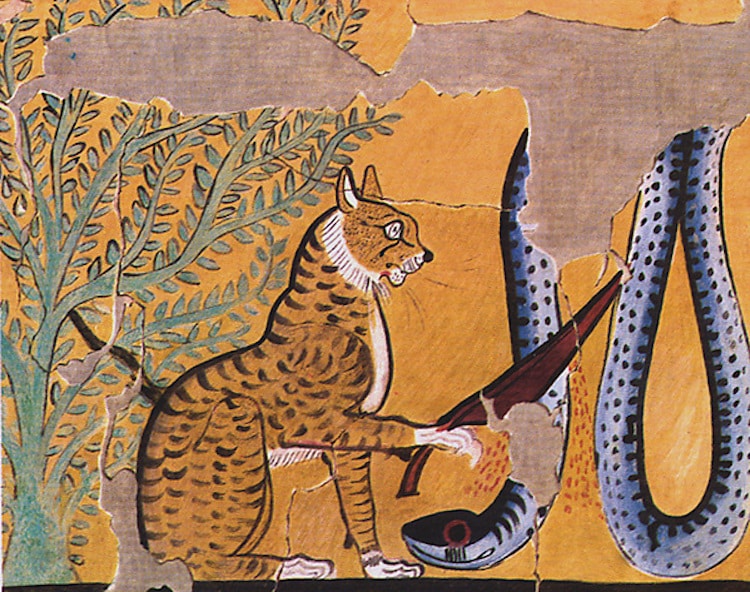
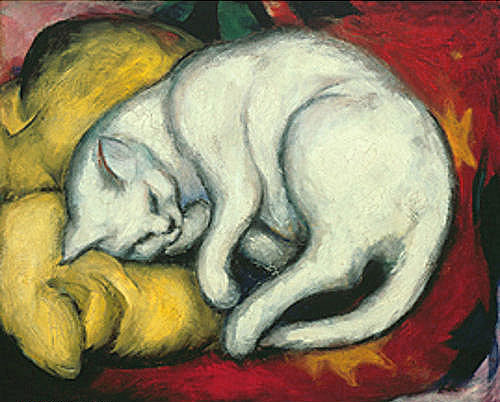
In a similar manner cats were protected in many areas of Asia for their use as vermin hunters. Cats have appeared in Chinese art for thousands of years. Domesticated for the same reason, as an important part of pest control. They were also favoured subjects for their distinct silhouette and rounded contours. 9 The Romans also celebrated the cat’s hunting skills, with the inclusion of a wild cat ensnaring a partridge in the famous Pompeian Casa del Fauno mosaic circa 2 B.C.E. 10 The importance of the cat as a hunter has remained a strong reason for the inclusion of the cat in art. As with most civilisations there is a desire to capture and represent moments of everyday life as well as their mythologies. It is clear in many cultures that the domestication of the cat is tied very closely to the agricultural changes of human society throughout the world. Many societies have honoured the cat as a mighty and useful hunter. In fact, the State Hermitage Museum in Russia’s Saint Petersburg (one of the most famous art museums of the world) “employs” over 70 cats. 11 The story proceeds that in 1795 the halls were infested with rats so the empress signed a decree sending Chazan cats, considered the best ratters, to the palace. The cats were granted status as official rat catchers and became favoured Russian pets. 12
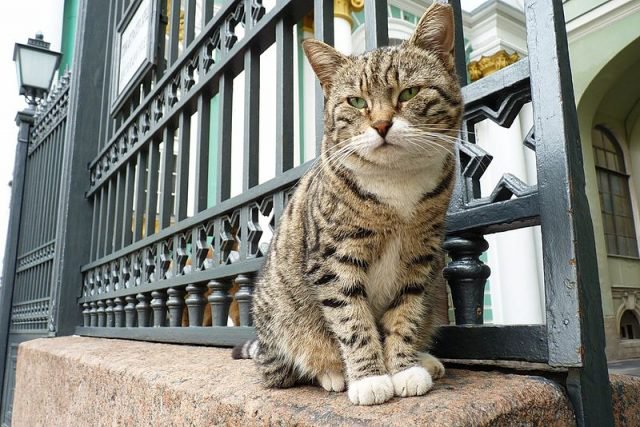
Mythological felines
Many cultures have included cats into their pantheon of gods, goddesses and mythology. The most well-known of course is Egypt with the goddess Bast/Bastet (the daughter of the sun god Re). 13 There are numerous drawings and engravings on sarcophagi and the walls surrounding them that depict powerful cats, or cat-headed goddesses. There are also adorning tombs for feline burial sites showing that the cat was elevated above the level of other creatures and in their passing were mourned, mummified and buried so that they too could pass into the afterlife. 14
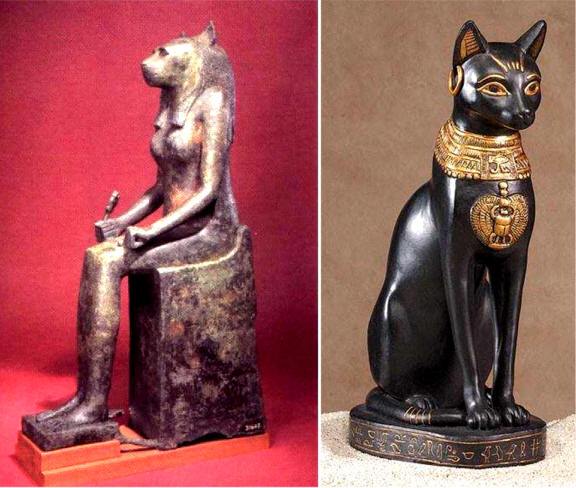
While many other animals were representatives of the gods, there is evidence that cats held the position of demi-god. It was believed that as such no cat could be owned except by a pharaoh, and therefore harming a cat was treason. 15 At the height of the popularity of the cat-headed goddess Bast killing a cat, even accidentally, was punishable by death. All dead cats were offered to Bast to live eternally by her side. 16 As messenger and servant of the goddess Bast, cats were often captured in art. One famous example of this can be seen at the British Museum in the form of a bronze cast cat statue adorned in jewellery. 17 The most famous story related to cats and their associated goddess concerns the importance of cats around the Egyptian home in defending humans by killing poisonous snakes. One myth depicts how Bast beheaded Apophis who was the underworld god and depicted as snake headed, thus symbolising how light triumphs over darkness, life over death. 18 Cats were called Mau derived from the sound of their cry and began to become associated with other mythologies. Even being seen as a symbol of the moon due to their nocturnal habits, and were considered the antithesis to the snake, a symbol of darkness and death. 19
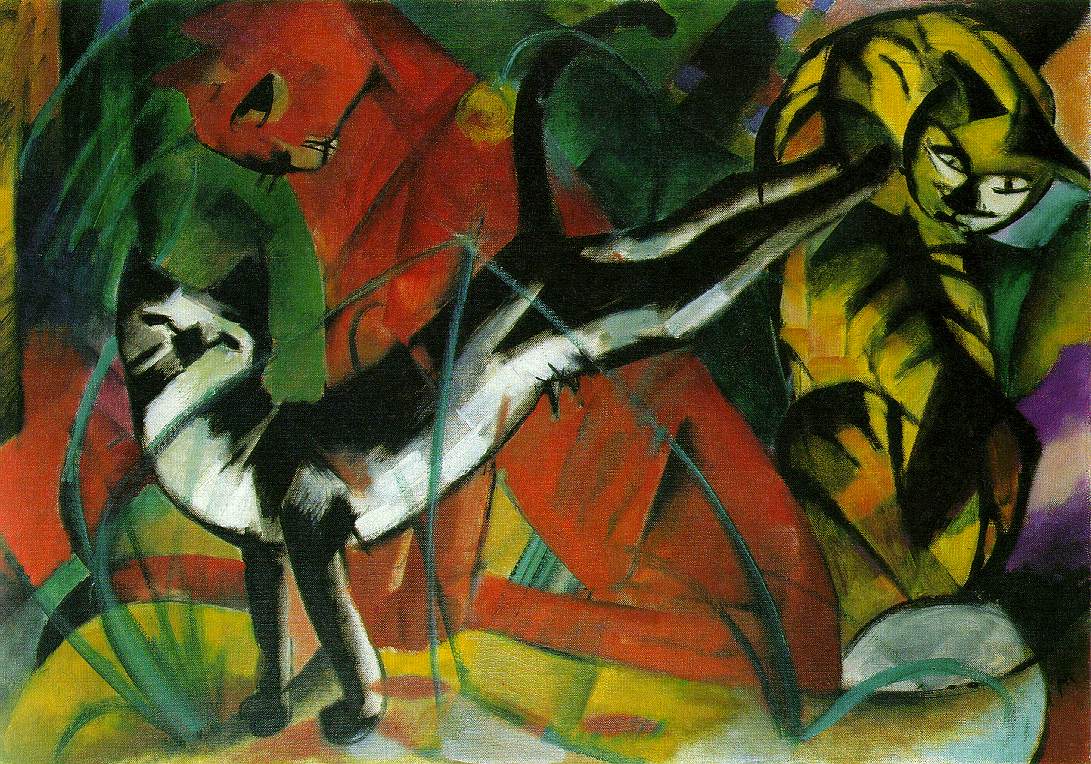
In the Islamic world cats were believed to be loved by Mohammed, the founder of Islam. One story exists of Mohammed’s cat Muezza who fell asleep on the sleeve of Mohammed’s robe. Mohammed, rather than disturbing his beloved cat, cut off the sleeve of his robe when he needed to leave. 20 A more definitive myth belongs to the Norse culture. In Norse mythology the wagon of Freyja, wife of Odin, was pulled by cats. A fact recorded in some of the earliest writings, where in Prose Edda it is mentioned that “when she travels, she drives two cats and sits in a chariot.” 21 They were apparently given to her by Thor and were said to be either blue or grey, and though large were still small cats. Like Bast, she was a goddess of hunting as well as love, and it is interesting the similar choice of cat as a sacred animal. 22 In Finnish mythology cats played a different role. They were believed to lead the souls of the dead on the dangerous journey through the underworld. 23
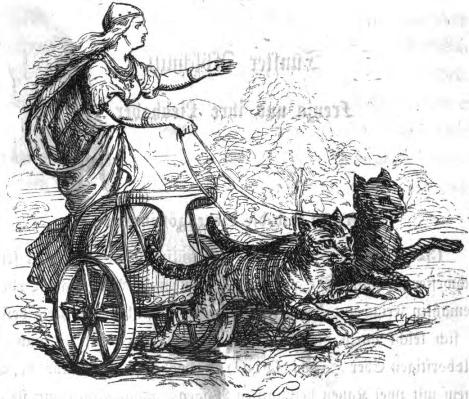
Moving further to the East and Asian culture: apparently the orient cat is the fourth sign of the Vietnamese zodiac (a number of myths surround why cat was not present in the Chinese zodiac, of which historians have offered that the cat was not yet introduced from India when the zodiac was developed) 24, and the word for cat, which is Mao, is phonetically identical for the word meaning octogenarian, thus cats have been associated with longevity. 25 However, white cats are considered being capable of becoming mischievous spirits, while dead cats can turn into demons. 26 In Japanese mythology the dead cat spirit is considered very dangerous as it can transform into human form, usually into the bodies of women that they kill by assuming their form. 27 While in India the cat is believed to be the vehicle for the sage Vidali and aesthetic cats depict the beauty of the animal kingdom. However, in Buddhist culture there are negative connotations, as like snakes, they serve to symbolism sin and ignorance as it is believed that neither mourned the death of the Buddha. 28 With such associations to the hunt, to love, to the afterlife it is unexpected that artists have desired to capture cats in their work.
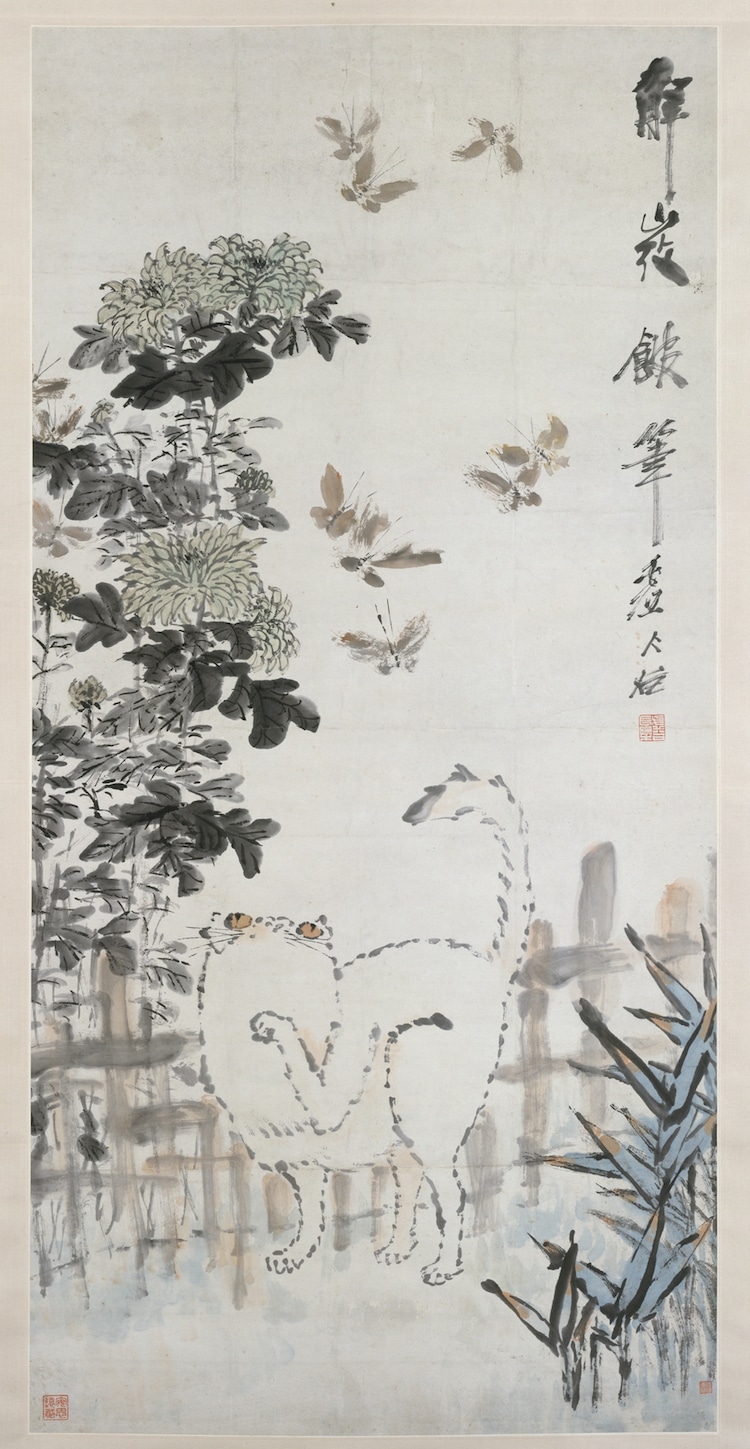
Evil by association
Whereas the role of cats in agrarian society and their depiction in ancient mythologies were positive, the cat in the medieval period was definitively negative thanks to superstition. Part of this could be attributed to the strong Christian messages of the period that actively worked to undermine ancient cultures, but part is also built off the previous associations with the afterlife. In cultures where women were linked strongly to superstitions it is found that they were often associated then with cats. The black cat as a symbol of heresy and paganism was present, with some early depictions of the Last Supper showing a cat curled at the feet of Judas. 29
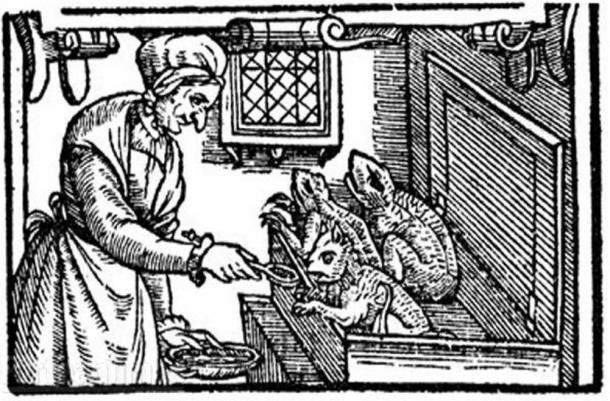
Some of it was more subtle, for instance Saint Agatha was the patron of lawyers and was depicted with a cat, but the cat acted to symbolise the evil qualities of lawyers. 30 A more extreme version of this is in a famous case from the 16th century of the trial of Elizabeth Francis, Agnes Waterhouse and her daughter Joan at Chelmsford Essex. In 1566 Elizabeth and her spotted cat Sathan were accused of causing the death of Andrew Byles who had made Elizabeth pregnant but refused marriage. Sathan apparently was given to Anges who changed it into a toad and caused the death of numerous farm animals also. Both women were hanged for their crimes and the cat killed. 31
In the 16th century cats became associated negatively with magic, making them demonstrative of the presence of evil. The word chatoyer was coined in France to mean ‘to shine like a cat’s eye’ and their reflective eyes were considered to glow with the fires of hell. 32 By the 17th century witches were believed to turn into cats, ride cats and to suckle kittens. 33 At this time the association between concepts of sexuality and promiscuity began to be linked to cats. 34 Furthermore the cat in Christian art began to be included to symbolise laziness and lust. 35 Such beliefs were recorded as part of folklore and fairy tale. One such was captured by the Brothers Grimm and described a shape-shifting witch who turns virgins into birds and cages them. A story that illustrator Arthur Rackham captured by expressing the malevolence of the hunting cat. 36
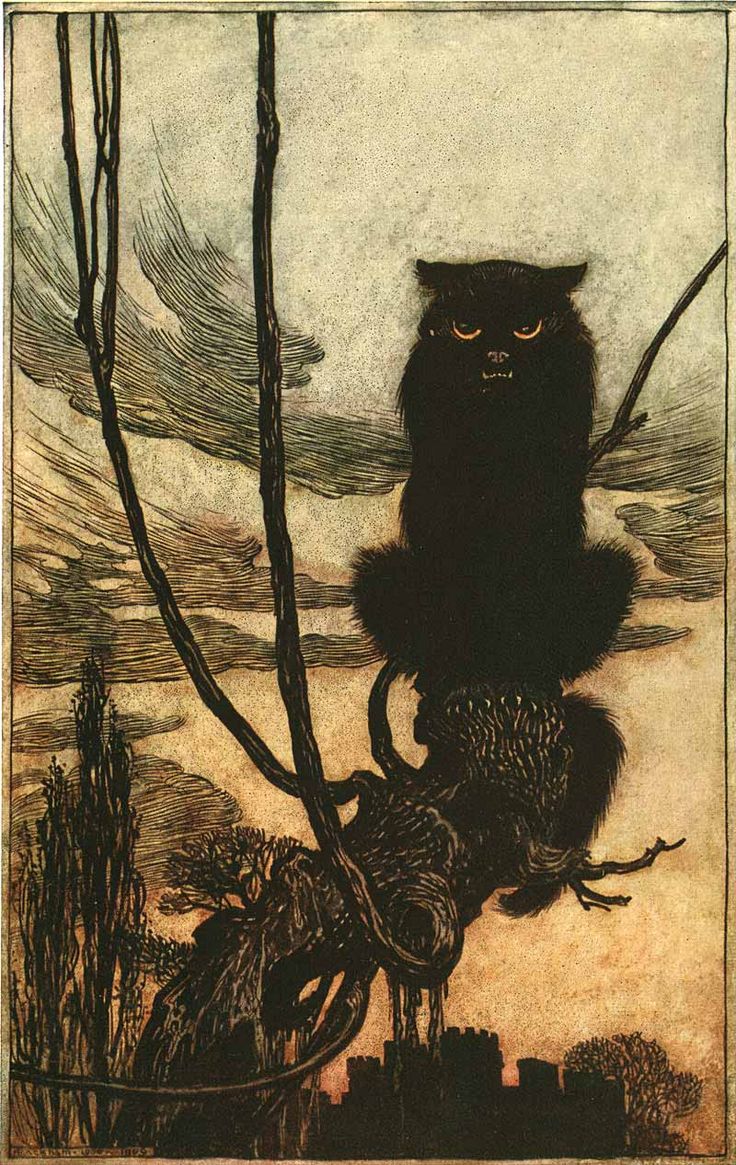
Interestingly, the sweeping deaths of the Bubonic Plague due to the rise in vermin in cities and towns could be considered linked to the increasing alienation and killing of cats. 37
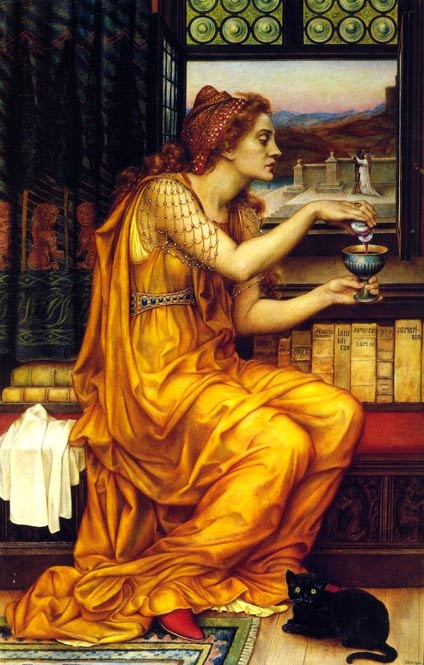
Thankfully the Renaissance dispelled ridiculous medieval superstitions, even going as far as to align cats with scholars. In an early theory of the four humors of the body the cat was even associated with the humor that related to unpredictability and saturnine, which many artists identified with. 38
Although Japan did not experience the same witch-hunts as medieval Europe it did present a mixed view of cats. Some myths could depict cats as peaceful spirits, but others also at times included demon cats. One such legend called ‘Bakeneko Rebellion of Nabeshime and The Cat Monster of Saga,’ which also was made into a kabuki play. The story depicts how when a retainer was killed his mother tells her sorrows to a cat and then commits suicide. The cat licks the mother’s blood and becomes an evil spirit to haunt the master. 39 It is interesting that the same attributes that resulted in the domestication, and at times deifying, of cats were also what caused their demonisation. With such huge contrasts in their representations it is easy to see why they have continued to capture our attention and be immortalised in art.
Can a cat be a social commentary?
We have seen how cats have actually been reflective of the values of the times. Artists are usually looking for a way to offer their unique voice, their point of view and to comment on their society. To do this the artists have often selected a particular aspect of the personality or role of the cat. For instance Pablo Picasso’s Still Life with Cat and Lobster focuses on their predatory nature, while Andy Warhol’s Blue Cat presents their playful side. 40 In relation to the use of the cat simply as an icon, Alexandre Steinlen is best known for his poster design for Le Chat Noir. 41 A number of stories exist about the naming of the cabaret: one was from the discovery of a dead rat under a divan; another a picture that appeared in Paris depicting a woman with décolleté liberally displayed and a black cat on her shoulder; 42 perhaps inspired by Edgar Allan Poe’s story ‘The Black Cat’; or finally an encounter with a black cat on the side walk at the cabaret’s construction. 43
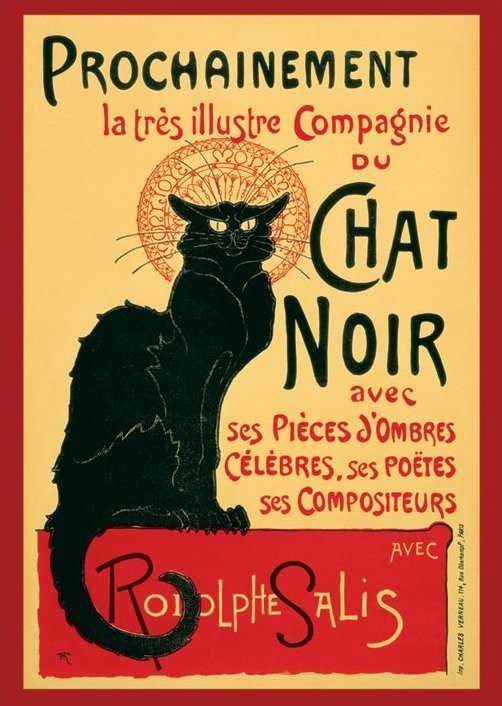
Interestingly, in the mid-19th century in Japan the government banned pictures of actors and courtesans believing that they were detrimental to public morals. 44 Artists finding a way around this began to portray famous kabuki actors instead as cats. 45 In a similar manner Louis Wain in the late 19th century in America drew cats walking on hind legs, grinning with wide mouths and wearing clothes. They would celebrate, play sports, drink cocktails, glare and wink while getting up to mischief. 46 They appeared in children’s illustrations, but also in comic scripts critiquing social mores that garnered him a number of famous admirers of the period. 47
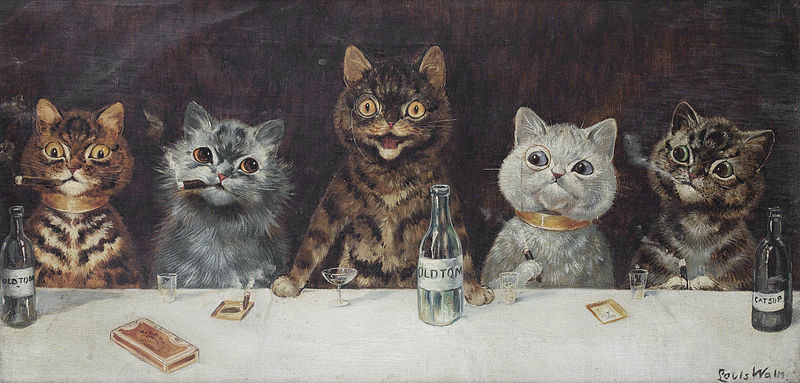
The cat in the artist’s studio
The most likely reason, however, for the presence of the cat in art is of course the presence of the cat in the artist’s home and studio. Even the simple presence of cats around artists was inspiring, with Renoir and Cassatt painting kittens, or Manet perceiving modernity and the black cat linked, or Picasso a dog lover who admired the untamed quality of feral cats. 48 Cats are also valued by artists as they require less attention and are more independent. However, the working studio can be isolating and a cat brings life to that space, while still providing artists alone time to thrive. 49
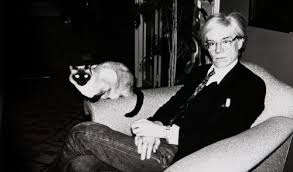
One such famous example is Andy Warhol who began his life in an apartment with his mother and 25 cats, which in 1954 inspired the hand-coloured lithographs for a picture book titled 25 Cats Named Sam and One Blue Pussy. 50 Jay DeFeo worked on her large-scale masterpiece The Rose under the watchful eyes of her cat Pooh, who appeared in many photos of her studio space in San Francisco. 51 Salvador Dali, the surrealist artist, kept an ocelot cat named Babou appeared in a number of his mixed media pieces. Anecdotal stories also include how Dali loved to take Babou on a harness to local cafes.
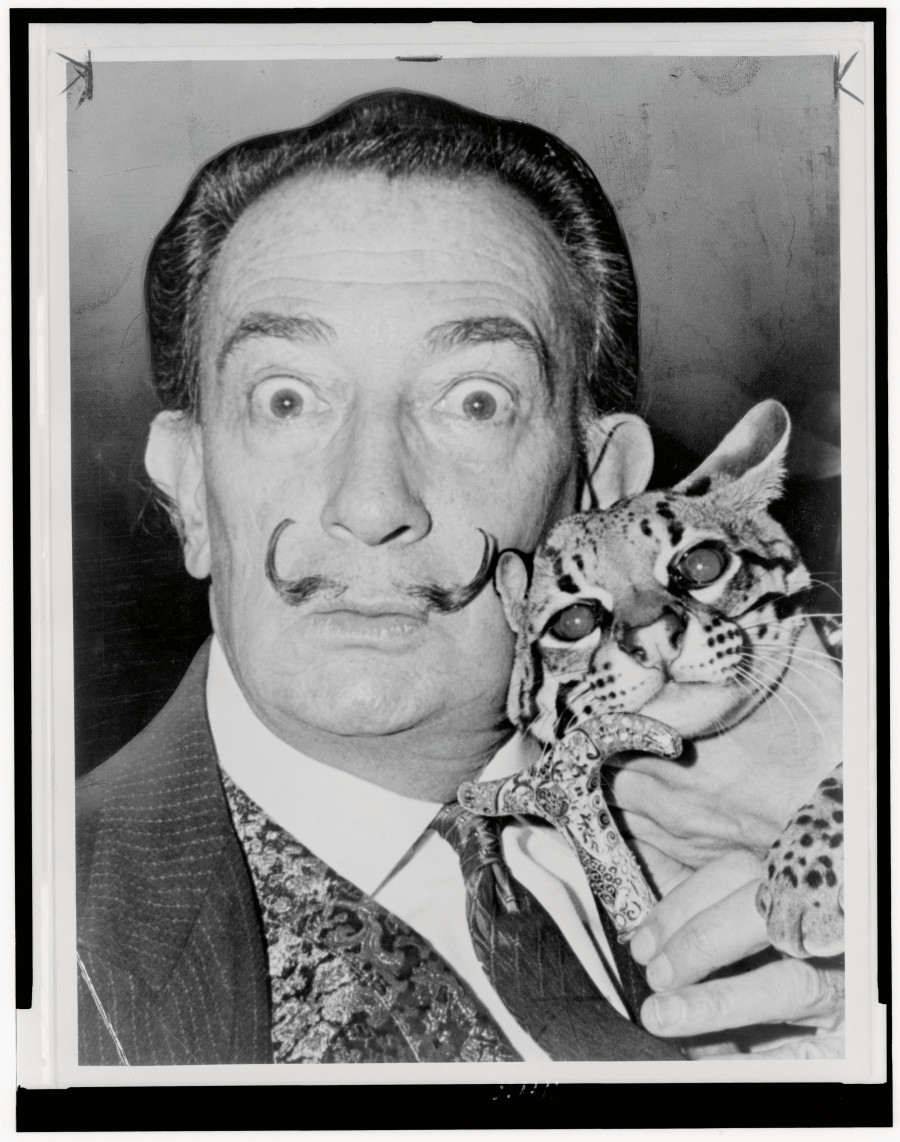
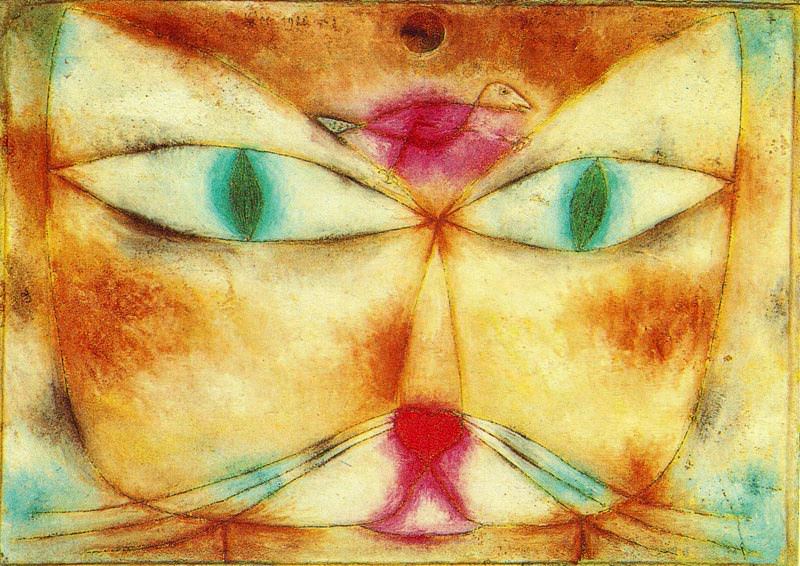
Many artists also used the cat as part of demonstrating experimental practices. They can be perceived as enigmatic, poised between domestic and nocturnally wild. 54 They resemble their dangerous big cat relatives behaviourally and visually, more so than their canine contrasts. 55 There is much available for the artist to draw upon while experimenting. Paul Klee practicing what he called “the pure cultivation of the means,” relating to the use of line, shape and colour for their own sake, created his painting Cat and Bird in 1928. 56 The picture is suggestive of a child’s drawing, as Klee believed children were close to the source of creativity. 57
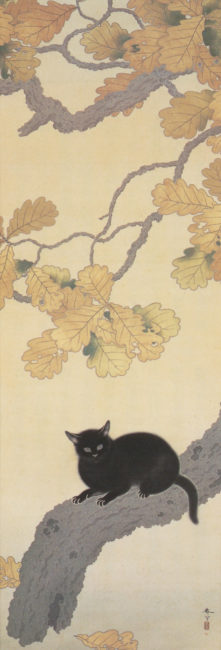
Shunso Hishida pioneered a movement of colours that replaced traditional line drawings in Japan called morotai. 58 However, it was not until he began a study of cats that combined the vague colour style with the traditional line drawings that he had success.
Internet cats and contemporary art
Cats continue to be captured in contemporary art, both at a High Art level and in a Popular Culture way. Who does not know about Hello Kitty or Pusheen or Grumpy Cat – all of which have their own social media accounts? So why has this fascination continued? Some argue that the alignment of cat’s faces reflect the alignment of young babies’ faces, thus evoking a biological need to nurture in us. 59 Another point of view is the one discussed in this article, which is due to cat’s presence in mythology and part of our collective storytelling milieu we are drawn to their myriad of representations. 60 Meaning that they appeal to our sense of belonging within our own culture, and that by continuing to celebrate and engage with cat memes this can be understood as engaging with modern icons of ancient ideas. 61 Or simply is it that like our ancient ancestors the presence of the cat as a valued member in our home inspires us to immortalise them.
Regardless I am certain that we will see many more decades of cat adoration in our art.
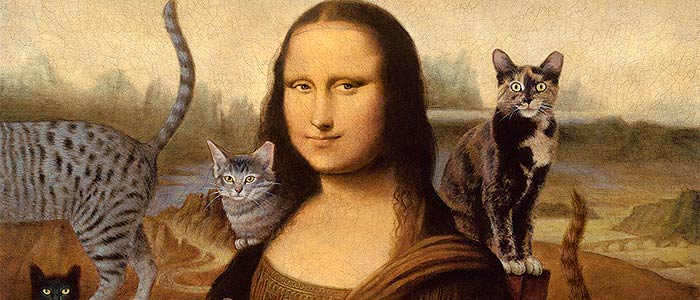
Works Cited
- Petcentric. (2018). Cats in Art. Retrieved from https://www.petcentric.com/articles/fun/cats-in-art/ ↩
- Cats in Ancient Egypt. (2018). Ancient Egypt Online. Retrieved from http://www.ancientegyptonline.co.uk/cat.html ↩
- Cats in Art. (2018). Kittens Lair. Retrieved from http://www.kittens-lair.net/history-and-famous-cats/cats-in-art.html ↩
- Werness, A. H. B. (2006). Continuum Encyclopedia of Animal Symbolism in World Art. London, UK: A&C Black ↩
- Grimm, D. (2017). ‘Ancient Egyptians may have given cats the personality to conquer the world.’ Science Mag. Retrieved from http://www.sciencemag.org/news/2017/06/ancient-egyptians-may-have-given-cats-personality-conquer-world ↩
- Grimm, D. (2017). ‘Ancient Egyptians may have given cats the personality to conquer the world.’ Science Mag. Retrieved from http://www.sciencemag.org/news/2017/06/ancient-egyptians-may-have-given-cats-personality-conquer-world ↩
- Grimm, D. (2017). ‘Ancient Egyptians may have given cats the personality to conquer the world.’ Science Mag. Retrieved from http://www.sciencemag.org/news/2017/06/ancient-egyptians-may-have-given-cats-personality-conquer-world ↩
- Cats in Ancient Egypt. (2018). Ancient Egypt Online. Retrieved from http://www.ancientegyptonline.co.uk/cat.html ↩
- Richman-Abdou, K. (2017). Cats in art: How our feline friends have inspired artists for centuries. Retrieved from https://mymodernmet.com/cat-art-history/ ↩
- Hanson, S. P. (2007). ‘Goddess, hunter, consort, thief.’ Art News. Retrieved from http://www.artnews.com/2007/06/01/goddess-hunter-consort-thief/ ↩
- Smithfield, B. (2017). The famous Hermitage Museum keeps 74 cats to keep its basements mice-free. Retrieved from http://www.thevintagenews.com/2017/03/22/the-famous-hermitage-museum-keeps-74-cats-to-keep-its-basements-mice-free/ ↩
- Smithfield, B. (2017). The famous Hermitage Museum keeps 74 cats to keep its basements mice-free. Retrieved from http://www.thevintagenews.com/2017/03/22/the-famous-hermitage-museum-keeps-74-cats-to-keep-its-basements-mice-free/ ↩
- Werness, A. H. B. (2006). Continuum Encyclopedia of Animal Symbolism in World Art. London, UK: A&C Black ↩
- Richman-Abdou, K. (2017). Cats in art: How our feline friends have inspired artists for centuries. Retrieved from https://mymodernmet.com/cat-art-history/ ↩
- Cats in Ancient Egypt. (2018). Ancient Egypt Online. Retrieved from http://www.ancientegyptonline.co.uk/cat.html ↩
- Cats in Ancient Egypt. (2018). Ancient Egypt Online. Retrieved from http://www.ancientegyptonline.co.uk/cat.html ↩
- Jones, J. (2015). ‘Stroke of genius: why do artists love cats?’ The Guardian. Retrieved from https://www.theguardian.com/artanddesign/jonathanjonesblog/2015/apr/16/artists-and-their-cats-matisse-dali ↩
- Werness, A. H. B. (2006). Continuum Encyclopedia of Animal Symbolism in World Art. London, UK: A&C Black ↩
- Werness, A. H. B. (2006). Continuum Encyclopedia of Animal Symbolism in World Art. London, UK: A&C Black ↩
- Cats in Art. (2018). Kittens Lair. Retrieved from http://www.kittens-lair.net/history-and-famous-cats/cats-in-art.html ↩
- Freya’s cats. (2018). Retrieved from https://earthandstarryheaven.com/2017/09/20/freyjas-cats/ p.24 ↩
- Mythology: Cats in Norse Mythology. (2018). Feline Forever. Retrieved from http://felineforever.com/cat-mythology-norse.html ↩
- Mythology: Cats in Finnish Mythology. (2018). Feline Forever. Retrieved from http://felineforever.com/cat-mythology-norse.html ↩
- Lui, J. (2009). Why no year of the cat? China Blog. Retrieved from https://chinablog.cc/why-no-year-of-the-cat/ ↩
- Werness, A. H. B. (2006). Continuum Encyclopedia of Animal Symbolism in World Art. London, UK: A&C Black ↩
- Werness, A. H. B. (2006). Continuum Encyclopedia of Animal Symbolism in World Art. London, UK: A&C Black ↩
- Werness, A. H. B. (2006). Continuum Encyclopedia of Animal Symbolism in World Art. London, UK: A&C Black ↩
- Werness, A. H. B. (2006). Continuum Encyclopedia of Animal Symbolism in World Art. London, UK: A&C Black ↩
- Hanson, S. P. (2007). ‘Goddess, hunter, consort, thief.’ Art News. Retrieved from http://www.artnews.com/2007/06/01/goddess-hunter-consort-thief/ ↩
- Werness, A. H. B. (2006). Continuum Encyclopedia of Animal Symbolism in World Art. London, UK: A&C Black ↩
- Werness, A. H. B. (2006). Continuum Encyclopedia of Animal Symbolism in World Art. London, UK: A&C Black ↩
- Werness, A. H. B. (2006). Continuum Encyclopedia of Animal Symbolism in World Art. London, UK: A&C Black ↩
- Werness, A. H. B. (2006). Continuum Encyclopedia of Animal Symbolism in World Art. London, UK: A&C Black ↩
- Werness, A. H. B. (2006). Continuum Encyclopedia of Animal Symbolism in World Art. London, UK: A&C Black ↩
- Cats in Art. (2018). Kittens Lair. Retrieved from http://www.kittens-lair.net/history-and-famous-cats/cats-in-art.html ↩
- Fuller, G. (2014). 10 best cat paintings. Retrieved from https://news.artnet.com/art-world/10-best-cat-paintings-13438 ↩
- Cats in Art. (2018). Kittens Lair. Retrieved from http://www.kittens-lair.net/history-and-famous-cats/cats-in-art.html; Ancient Origins. (2018). Retrieved from http://www.ancient-origins.net/myths-legends/witch-familiars-spirit-guardians-and-demons-006261 ↩
- Hanson, S. P. (2007). ‘Goddess, hunter, consort, thief.’ Art News. Retrieved from http://www.artnews.com/2007/06/01/goddess-hunter-consort-thief/ ↩
- Lombardi, L. (2015). Cats in Japanese art. Retrieved from https://www.tofugu.com/japan/ukiyo-e-cats-in-japanese-art/ ↩
- Petcentric. (2018). Cats in Art. Retrieved from https://www.petcentric.com/articles/fun/cats-in-art/ ↩
- Petcentric. (2018). Cats in Art. Retrieved from https://www.petcentric.com/articles/fun/cats-in-art/ ↩
- Walton, G. (2017). Le Chat Noir or The Black Cat Cabaret of Victorian Times. Retrieved from https://www.geriwalton.com/le-chat-noir-or-the-black-cat/ ↩
- Le Chat Noir. (2018). The evil thoughts of a decadent mind. Retrieved from http://evildandy.blogspot.com.au/p/le-chat-noir.html ↩
- Lombardi, L. (2015). Cats in Japanese art. Retrieved from https://www.tofugu.com/japan/ukiyo-e-cats-in-japanese-art/ ↩
- Lombardi, L. (2015). Cats in Japanese art. Retrieved from https://www.tofugu.com/japan/ukiyo-e-cats-in-japanese-art/ ↩
- Wright, A. (2016). Before cat memes, there were Louis Wain’s controversial cat illustrations. Retrieved from https://www.atlasobscura.com/articles/before-cat-memes-there-were-louis-wains-controversial-cat-illustrations ↩
- Wright, A. (2016). Before cat memes, there were Louis Wain’s controversial cat illustrations. Retrieved from https://www.atlasobscura.com/articles/before-cat-memes-there-were-louis-wains-controversial-cat-illustrations ↩
- Hanson, S. P. (2007). ‘Goddess, hunter, consort, thief.’ Art News. Retrieved from http://www.artnews.com/2007/06/01/goddess-hunter-consort-thief/ ↩
- Brooks, K. (2015). ‘Portraits of famous artists, and the cats that kept them sane.’ HuffPost. Retrieved from http://www.huffingtonpost.com.au/entry/artists-and-their-cats_n_7112320 ↩
- Andy Warhol’s Greatest Love: Cats. (2013). Artsy. Retrieved from https://www.artsy.net/article/editorial-andy-warhols-greatest-love-cats ↩
- Archives of American Art Smithsonian. (2018). Retrieved from https://archivesofamericanart.tumblr.com/search/caturday ↩
- Paul Klee. (2018). The Great Cat. Retrieved from http://www.thegreatcat.org/the-cat-in-art-and-photos-2/cats-in-art-20th-century/paul-klee/ ↩
- Brooks, K. (2015). ‘Portraits of famous artists, and the cats that kept them sane.’ HuffPost. Retrieved from http://www.huffingtonpost.com.au/entry/artists-and-their-cats_n_7112320 ↩
- Jones, J. (2015). ‘Stroke of genius: why do artists love cats?’ The Guardian. Retrieved from https://www.theguardian.com/artanddesign/jonathanjonesblog/2015/apr/16/artists-and-their-cats-matisse-dali ↩
- Jones, J. (2015). ‘Stroke of genius: why do artists love cats?’ The Guardian. Retrieved from https://www.theguardian.com/artanddesign/jonathanjonesblog/2015/apr/16/artists-and-their-cats-matisse-dali ↩
- Paul Klee, Cat and Bird. (2018). MoMA. Retrieved from https://www.moma.org/collection/works/79456 ↩
- Paul Klee, Cat and Bird. (2018). MoMA. Retrieved from https://www.moma.org/collection/works/79456 ↩
- Miller, K. K. (2016). Famous Japanese painter’s centuries-old cat artwork proves Japan has always loved felines. Retrieved from https://en.rocketnews24.com/2016/04/21/nothing-is-better-than-cats-lounging-under-various-beautiful-trees%E3%80%90art%E3%80%91/ ↩
- Shapiro, J. (2012). ‘Cats on the internet: A psychological explanation.’ Forbes. Retrieved from https://www.forbes.com/sites/jordanshapiro/2012/12/07/cats-on-the-internet-a-psychological-explanation/#bcb5e9560790 ↩
- Shapiro, J. (2012). ‘Cats on the internet: A psychological explanation.’ Forbes. Retrieved from https://www.forbes.com/sites/jordanshapiro/2012/12/07/cats-on-the-internet-a-psychological-explanation/#bcb5e9560790 ↩
- Shapiro, J. (2012). ‘Cats on the internet: A psychological explanation.’ Forbes. Retrieved from https://www.forbes.com/sites/jordanshapiro/2012/12/07/cats-on-the-internet-a-psychological-explanation/#bcb5e9560790 ↩
What do you think? Leave a comment.











I’m a watercolorist and I love cats. Nearly all of my close friends are some kind of artist or are artistically inclined, and they also have cats.
Thanks for sharing Michael. Why do you think all of you have embraced the cat?
Thanks for writing! I think it is the meditation and the calmness of taking care of them that helps me to concentrate and be focused when needed be.
I never knew that so many great artists loved cats — but why should I be surprised? Cats are beautiful, breathing works of art. Anyone who lives with a cat knows that its every move, every flick of an ear or a whisker, is a graceful expression of its innate artistic self. I have been owned by many cats in my long life (two formerly feral sisters at the moment), and they have always reminded me that feline elegance is as natural to them as a heartbeat.
Very interesting! So intrigued that Dali owned an ocelot!
I know right?! That was one of the biggest surprises I came across when researching this article – that and how many cats Warhol lived with.
Cats sell pictures. Particularly kitzy cats. Many artists use them to fund the work they really want to do, but which doesn’t sell. Easy.
Artists favour cats because cats are low maintenance and quite happy to be left alone meaning the artist can focus more on their work.
Dogs on the other hand can get restless and want attention, walks, etc.
I think you have a point there.
Still, I’d rather be a dud with a dog than an artist with a cat: you can’t beat the exuberance of that bounce-spring-headbutt-in-the-balls-three-frenetic-laps-of-the-hall-“You’re home!”-bolt-up-the-stairs-slam-the-wife-face-down-in-her-keyboard-“He’s home!”-scramble-down-the-stairs-leash-in-mouth-“Where we going?”-quick-pause-for-a-scratch-delighted-grin thing my dog does of an evening.
That “meh” the cats do just doesn’t cut it with me.
My cat runs over to see me every time I come home. She likes to stay outside when I leave. And she stays on my porch waiting for my car to pull in. She then runs over to my car when I get out and sits and leans her head back, waiting for her head rub greeting. And If I don’t greet her well enough, she is pissed after, and will ignore me.
‘That “meh” the cats do just doesn’t cut it with me.’
On the whole, I would agree with you that dogs are quite simply more demonstrative and adoring. But I have known two cats…
Lambchop was my landlady’s cat when I lived in Carshalton. As I worked in Sutton but the landlady in town, I would invariably be home first. As I put my key in the lock (a maisonette), I would hear the bounding echo on the stairs beyond, and by the time I’d opened the door Lambchop would be there at the bottom, looking expectantly at me.
I would have to close the door and put down my briefcase, in doing so allowing her to jump on my shoulder. She would perch there, claws digging into the jacket shoulder-padding for traction, as I climbed the stairs and made my way into my room. She would jump on the bed and wait, watching as I changed into something a bit more comfortable and, as soon as she saw I was done she would stalk into the living room, ensuring I followed.
There we would play our habitual game of “Stalk and kill Palfreyman’s fist” until she was bored or I was too scratched and bleeding from her efforts to continue. After that it was telly time as she purred and rubbed her head against the back of mine, sitting as she was on the back of the sofa, just behind me.
At night, since the landlady was strict about not letting her into her room, Lambchop would scratch until I let her into mine, curl once about my head, and fall asleep…
The other cat was even more loving.
But yes, cats aren’t dogs, to state the bleeding obvious.
Hi Tierra,
Yes, that is definitely something I found in the research. Although many artists simply commented on their passive, calm nature and that they did not interrupt, I also interpreted that as they are low maintenance. Which makes sense. I actually wondered how many writers also have cats, or if they go the other way and prefer dogs because it helps remind them to walk away from their work sometimes?
I have dogs to get me away from the easel and into the fresh air occasionally. I have cats too but that is another story.
My cats are very social. They come running and start rolling on the ground when I get home. They follow me around the house, and they love to cuddle. They don’t like it when I’m gone.
Leonardo da Vinci was a cat lover and gave a huge contribution to fight superstitions on cats!
Medieval artists had some terrible skills to add cats in their artworks.
They were also bad at lions although lions had a much much higher reputation among medieval Christians.
The same applies to babies. Pre-Davinci babies look for the most part like old men. My 8 year old daughter had a great time taking photos of the ca 1200-1400 era babies at the Louvre. It made for a hilarious (or disturbing) collage.
This is actually a common problem in art of all kinds, at all times and places. People often paint their idea of what a thing looks like, rather than trying to copy what they actually see. And since everyone else in their culture shares that idea of what the thing looks like, no one notices (until conventions changed or until photography was invented).
If you went to a children’s art class today, most drawings would be similarly idealized.
The Greeks were much better at cats. They were often very accurate, as were the ancient Egyptians.
Some years ago I went to a Van Gogh exhibit in Los Angeles, and while contemplating Wheatfield with Crows I overheard the guy behind me say “No wonder he killed himself. He couldn’t even paint a crow right.”
Different time, different way of seeing cats?
The cats are probably an afterthought, a piece of set decoration, and were not as carefully studied as, say, the surface effects of fabrics, metals and jewels. These things were imitated closely to flatter the subject and prove the skill of the artist.
Interesting. I’m a great cat lover, and years ago I used to be very good at sketching.
That’s amazing–I don’t like cats, and many years ago I put up some wallpaper and didn’t do a very good job.
If an artist own a cat that means that is a less stressful guy than others.
YouTube artists always seem to have cats. Maybe it really is a thing.
Every cat art is just PURE GOLD. I would pay high amounts of money to have them as posters or wall scrolls.
Cats appear a lot in Japanese art.
I found that too and was surprised, although I don’t know why, but there does seem to be more Japanese art with cats than really any group other than the Ancient Egyptians. I think that is linked to the fact cats are present in many myths, but not always negative mythology as it is in Europe.
There’s a practical reason for Japan’s fondness of cats: its cities have always been, and still are, infested by mice and (to a lesser extent) rats.
This is a great article – bravo, it is time cat’s got their artistic due.
Not a painting, but If you like cats, try the short story ‘Tobermory’ by Saki.
I love Tobermory.
Lovely article. I love cats. So peaceful yet amusing.
No mention of Gwen John?
Her cat paintings are so expressive!
Very interesting article! It is very well researched.
I. Need. To. Get. A. Cat. Now.
Why do villains always have cats?
So true! Examples:
– Dolores Umbridge in Harry Potter.
– Dr. Evil in Austin Powers.
– Don Corleone in The Godfather.
Hmm. In some art, dogs were seen as symbols of loyalty and companionship while cats symbolized infidelity, but I wonder why cats are depicted as loyal companions to villains in pop culture (aside from old superstitions associating them with evil/magic)… I think their aloofness/stoicism is perhaps meant to mirror the lack of human empathy in villains. I mean, cats are pretty self-centered.
Upvote. Could be an article of its own.
I live with a cat and think there’s a lot of rubbish talked about them. My cat is not elegant: he licks his arse. He is interested mainly in food and warmth. He is not a furbaby, miniature human or any of the other twaddle you hear repeated about cats. He is a small furry predator that has the good fortune to suit the human lifestyle well.
And of course he’s mummy’scuddlywuddlypuddytatyesheis. But that’s my point of view, not his.
A fascinating read with brilliant insights! I always personally thought cats had an unspoken charisma that blended well with their mysterious nature. It’s no surprise that many noteworthy authors like Murakami and Gaiman view them as mediums and traversers of varied dimensions and worlds. They’re so lovely. Wonderful article!
I’ve never been a ‘cat’ or a ‘dog’ person, but I do a lot of dog-sitting! Having said that, I thoroughly enjoyed this obviously well researched article that was equally obviously written from the heart. A fine read indeed and thank you. One comment, or rather an observation – it’s curious how cats live with human society and yet manage to maintain their independence (for the most part) whilst dogs seem to be dependent on human society.
That’s so P.G.Wodehouse…
I love cats, and so I love this article! 🙂
Every space a cat occupies is made beautiful. Which is one of the reasons I have five of them.
I love you for writing this topic. I’m no artist but I do write,on occasion quite well….I think. I have a cat called Charlotte. She is white-furred with a black tail,a black splodge on her back,one black ear and one pink ear.
I start writing about 7am every day after feeding her. She routinely then comes up to my study,jumps up on my desk and curls up next to my keyboard.I find it very comforting when I stroke her and she is very affectionate,often helps me sit back and think. She is no trouble.
I love dogs too but I find them too demanding within the requirements of my life and leave them to others to have and look after. I love all animals. OK, mystical and emotional moment over and I will now resume writing.
… You really do not want to know what I am writing about.
A story about a mouse being nailed to a cross?
I also find it interesting that cats are so frequently depicted, in all kinds of arts, in such a gendered way, usually associating them with the feminine and femininity.
I am sure the frequent association of cats with femininity and dogs with masculinity also has absolutely nothing to do with the way it seems much more culturally acceptable to dislike cats than dogs.
I recently came across a fascinating book called The Cat 3,500 Years of the Cat in Art by Caroline Bugler. Highly recommended.
I love seeing pictures of famous artists with their creative mewses.
Love it!
‘Cats in Renaissance art’ is my new favorite thing.
For an artist, the best thing about cats is their independence. They are not attention seeking in the way a dog is,and they dont require much of your time….so you can be in the middle of a painting with all your colours mixed and the cat will not interrupt you looking for attention…unless you forget to feed it.
I’m an artist and can’t bear cats. Much prefer my Guide Dog.
Creative article, I love it! And cats are beautiful!
I paint a little and my cat is always trying to climb onto wet canvases and she’s obsessed with the glass of water that I keep my brushes in. She also loves the movement of the brushes. In general, she’ll try to get between me and any activity that involves her not getting my full attention.
Love this article. Cats have seemingly always been a cross-cultural artistic muse!
I like Louis Wain who drew and painted nothing but mad-eyed cats. But then, he suffered from a serious mental illness and fixated on them a little too much. 🙂
As a cat lover I was immediately drawn, but honestly this was a easure to read. Your historical section was very thorough and I love how you rounded the discussion towards cats in the art communities. This actuator made me curious about animals connection with the arts. Some cats and dogs are known for interacting with paints and even with music.
I’m an artist and I love cats. It’s nothing to do with art, though – I just love cats.
As a huge lover of cats I saw this and I had to give it a read. As a person who likes to draw I find myself using my cats as inspiration. Some of this was definitely very interesting to read.
As someone who has two cats, thanks for this piece! And on a separate note, i find it very upsetting and disturbing when people compare cats and dogs.
As someone who has two cats, thanks for this piece!
Cats have an advanced and inate sense of good taste.
This is a great article. On a personal note, I read it with a cat on either side of me, and my main interests are scholarship and the arts. It’s a pretty fun stereotype to live up to imo; cats are compatible with the sedentary academic lifestyle, since they’re willing to just sort of chill with you adjacently and let you do your thing. Reminds me of the Medieval Irish poem “Pangur Bán,” in which the speaker, who is some type of scholar, compares the practice of logic to his pet cat’s skill at hunting mice.
I also feel like the duality of feline representation in art and history (their association with holiness/skill versus devilry/sloth, like you mentioned) relates pretty easily to small cats’ status as both hunters and prey in their natural habitats. It’s part of why their behavior seems so bizarre to us; they’re at the center of the food chain, so they have to be good at both hunting and hiding.
I’m a huge fan of fine art portraits of cats!
As a professed cat lover, I was enthralled by this article. I particularly enjoyed the brief foray into Egypt, as I once held a high interest for Egyptology as well. Cats and humans have an interesting companionship, and I thought it fascinating to read about the companionship immortalized through various works of art throughout the ages.
Well done!
Such an intriguing article! The presence of cats only improves art in my opinion.
The only downside to being an artist with cats is how often my shorthair Paul will see a paintbrush in use and think, ‘Ah! Perfect to rub my face all over!’ and shove the brush halfway across the canvas. Outside of that, the line ‘…the working studio can be isolating and a cat brings life to that space, while still providing artists alone time to thrive,’ is exactly right. I can’t let in my dogs while I work, because they need to be watched to make sure they’re not getting into trouble, nor am I able to much done around human non-artists. Cats (other than Paul, a deeply weird specimen who I adore) have the perfect balance of affection and desire for personal space that lets them keep you company without smothering you or being overly distracting. But if I take a break every now and again to scratch under Paul’s neck when I should be meeting deadlines, that’s between me and him.
As Freud noted, “Time spent with cats is never wasted.” I used to agree. After living with a feline for 22 years, who died in 1991, I never entered another mouser relationship out of fear that the pet would outlive me . . . and then what?
Sadly, in recent years, to fill that emotional chasm, I have taken care of numerous friends’ cats, and many have proven psychotic or annoying as that T.S. Eliot musical. Quite possibly they contracted the bilious neuroses of their owners.
Surprisingly, I have recently developed a fondness for my new Dyson vacuum cleaner. I leave it out in the living room, and once or twice a day I let it purr over my rug, whether necessary or not. No cat litter. No Purina Cat Chow. And if I die, I know dozens of folks who would take care of it with unbounded fondness.
Engrossing article, by the way,
LOVE cats
Cats are famous in science too. Schrodinger’s cat of uncertainty and quantum entanglement is my all time favorite.
It’s interesting how cats have often been linked to women, and strong women too in the past and mythology. Now we have the “crazy cat lady” trope but is there not something powerful about a woman being alone?
Cats are just beautiful creatures. They are powerful but have graceful and soft curves too. This article has an interesting take on the history of how cats came to be iconic in our world.
Read Bukowski’s book about cats it is great!
For a thorough account of the interest in cats through the ages, the idea that cats having “9 Lives” seems to be short-sighted in terms of the longevity this article covers. You, indeed, cause me to rethink the lure of cats and I want to revisit the expressions involving cats in visual pop culture to examine further how their images are more than mere admiration.
Cat appeal is a curious thing. While dog adoration is fairly straightforward, the notion of cat seems different, somehow outside peopledom. I am a dedicated dog enthusiast (I have always wanted a tail; I was born in Year of the Dog; I have a doggish personality) and yet, cats interest me. What is the draw? It must be a type of savage allure to the luxuriousness and yet ferocity that lies within C.A.T.
What a great insight into the weird and wonderful lives of our feline friends! I have lived with cats all my life, and feel sorely lost without their mysterious and fun presence.
I’m so glad I stumbled upon this article. My husband, a historian and scholar, is always so worried about his love for his “cat friends” (our two cats). He often says he feels crazy that his best friends are cats (he does have a best friend, but he lives in another state). I tell him all the time that it is completely normal to “talk” to your cat and consider them friends or family. I just had no idea about all of this history. He will feel better when I share with to him. Haha. Thanks!
I do have a thing for cats too but i prefer dogs more.
This seems like such a strangely specific topic for an article yet I’ve always noticed the relationship between cats and art. A lot of musicians I know are cat lovers and I wonder if there’s some sort of psychological thing to explain it…
Interesting, I am also a cat lover and I have also some sketch of my cat.
Well written article regarding artists and their love of cats.
Very well written about artists and their association with cats.
would be cool to delve further into some of these ideas- notable French film director Chris Marker used cats in almost all his major works, and identified with them fiercely.
Ahem! I, possibly sure NOT to have any pets yet. Nevertheless, if I have to ….I will surely pet a cat.
Very Creative and great
Read the role of the cat in Michael Connelly’s recent “Dark Sacred Night” (2018) — and you might have second thoughts about these unsavory creatures.
Really interesting article! I never knew the reason behind that perspective shift on cats, from their early adoration to their subsequent demonization. I appreciated your inclusion of great references to support the story. Great read!
This was a really interesting read. I recently also read a book called Cinema is a Cat and am fascinated with the influence cats have on new media. This provided a very extensive background to that.
Is anyone gonna talk about how many author photos are men with cats and a pipe?
The title grabbed my attention, and I’m so glad it did. This was a really fascinating read.
Very interesting on the history of cars in art, especially after the cat video phase has waned from its height.
this was a fun read